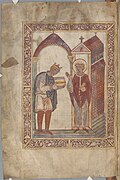Top Qs
Timeline
Chat
Perspective
May 27 (Eastern Orthodox liturgics)
From Wikipedia, the free encyclopedia
Remove ads
May 26 - Eastern Orthodox Church calendar - May 28
This article needs editing to comply with Wikipedia's Manual of Style. In particular, it has problems with using bold text for emphasis - see MOS:NOBOLD. (May 2019) |

All fixed commemorations below celebrated on June 9 by Orthodox Churches on the Old Calendar.[note 1]
For May 27th, Orthodox Churches on the Old Calendar commemorate the Saints listed on May 14.
Remove ads
Saints
- Hieromartyr Therapont of Sardis, Bishop, by beheading (259)[1][2][3][4][5]
- Martyr Julius the Veteran, at Dorostolum in Moesia (297)[2][6]
- Virgin-martyr Theodora, and Martyr Didymus the Soldier, of Alexandria (304)[2][7]
- Martyr Eusebiotus, by fire.[8]
- Martyr Alypius, by stoning.[9]
- Martyr Juliana.[10][note 2]
- Hieromartyr Helladios, Bishop (4th century)[2][12]
- Saint Michael of Parekhi, Georgia (8th-9th century)[2][13][14]
- Saint Basil of Khakhuli, son of King Bagrat III (11th century)[2][15][16]
Remove ads
Pre-Schism Western saints
- Saint Restituta and Companions (272)[17][18][19][note 3]
- Saint Eutropius of Orange (475)[19][20][note 4]
- Venerable Melangell of Wales, Abbess (590)[19][21][note 5]
- Martyr Ranulf (Ragnulf), in Thélus near Arras in France (700)[19][22][note 6]
- Venerable Bede the Confessor, Hieromonk of Wearmouth-Jarrow (735)[18][23][24]
- Saint Bruno of Würzburg, Bishop of Würzburg (1045)[19]
Post-Schism Orthodox saints
- Venerable Therapont of White Lake, Abbot of Byelozersk (White Lake) and Mozhaisk (1426)[2][25][26]
- Saint Philip I, Metropolitan of Moscow (1473)[27]
- Venerable Therapont of Monza, Abbot of Monza (1597)[2][28][note 7]
- Venerable Hiero-schema-monk Lazarus of Pskov-Caves Monastery (1824)[2][29]
- Saint John the Russian the Confessor, whose relics are on the island of Euboea (1730)[2][30][note 8]
Other commemorations
Icon gallery
- St. Julius the Veteran.
- Mosaic of the Theotokos and Christ child, between St. and St. Restituta (Naples Cathedral - Chapel of St. Restituta).
- Shrine of St. Melangell.
- A page from a copy of Bede's Lives of St. Cuthbert, showing King Athelstan presenting the work to the St. Bede. This manuscript was given to St. Cuthbert's shrine in 934.
- St. Bede the Venerable.
- Saint Bruno of Würzburg in a stained glass window from the parish church of Liesing.
- St. John the Russian, whose relics are on the island of Euboea.
- St Alexey (Mechev), Priest of Moscow.
- The Large Sakkos of Photius, created in the late Byzantine era for Photius, Metropolitan of Moscow around 1417.
- Venerable Nilus of Stolobny Island.
Remove ads
Notes
- The notation Old Style or (OS) is sometimes used to indicate a date in the Julian Calendar (which is used by churches on the "Old Calendar").
The notation New Style or (NS), indicates a date in the Revised Julian calendar (which is used by churches on the "New Calendar"). - "At Sora, in the time of Emperor Aurelian and the proconsul Agathius, St. Restituta, virgin and martyr, who overcame in a trial for the faith the violence of the demons, the affections of her family, and the cruelty of the executioners. Being finally beheaded with other Christians, she obtained the honour of martyrdom."[18]
- "Born in Rome of a noble family, she fled to Sora in Campania in Italy to escape persecution under Aurelian but was martyred there with several companions."[19]
- In Iconography she is shown together with her guardian angel.[17]
- Born in Marseilles, he succeeded St Justin as Bishop of Orange in France, when the diocese had been laid waste by the Visigoths.
- A holy virgin who lived as an anchoress in Powys in Wales. Her shrine is in Pennant Melangell.
- He was the father of St. Hadulph, Bishop of Arras-Cambrai.
- His feast day is celebrated on December 12. On this day is celebrated the holy ascetic's name-in-common with Saint Therapont of Sardis and Therapont of White Lake.
Remove ads
References
Sources
Wikiwand - on
Seamless Wikipedia browsing. On steroids.
Remove ads














